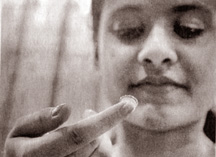
Eye on infection
Not reading the instruction manual can get you in trouble. Especially
if you have just purchased a pair of contact lenses and you skip the
part about cleaning lenses.
Disease surveillance (supervision) networks in Singapore and Hong
Kong have detected lenses leading to eye irritation. A trained
optometrist and Scientific Programme Manager with anoptical company,
Gunter Wong, says keeping your lens clean is absolutely crucial to your
visual health.

Though rare, fungal infection in contact lenses is known to have
consequences on the eyes. As evidence from the East shows, infections
can grow silently, undetected in the cornea and if they do not respond
to anti-fungal agents, only surgery can help remove the white patches
they cause, Dr. Wong says. Appropriate and regular cleaning of lenses
with the multi-purpose solution is essential, he adds.
The solution provided along with the contact lens is a multi-tasking
solution, "It cleans, disinfects, rinses and soaks the lens to keep it
clean and free from any infection," he explains, during a recent visit
to Chennai.
Eye care practitioners will have to communicate this to the patient,
as research shows that contact lens wearers allow their physicians,
contact lens specialists and optometrists to influence their decision,
Anand Mote another product Manager, adds.
There are an estimated 0.8 to one million contact lens users in
India. This figure is likely to grow, given the increasing disposable
income in the hands of youngsters, and the launch of superior lens care
systems in the market, Mote adds. However, the percentage of
non-compliance with cleaning procedure among lens users is as high as in
the developed nations which touch 60-70.
That is precisely why awareness must be generated about the upkeep of
lenses. Dr. Wong cautions people to watch out for red eyes, watering and
photophobia or inability to face the light. While these are symptoms
that need not necessarily have a fungal cause, it is essential to seek
professional help, he adds.
The Hindu
Girl's heart re-starts after donor organ is removed
A British girl is thought to have become the first heart transplant
patient in the U.K. and possibly the world to have had her donor organ
removed and her own heart re-started, a London hospital said.
Hannah Clark from South Wales had a heterotopic transplant operation
known as a "piggyback", because the donor heart was placed next to the
original organ 10 years ago.
|

Hannah Clark - Pic: AP
|
However, complications arose after her body recently started reacting
badly to the drugs she had to take to stop her body rejecting the new
heart, and surgeons took the decision to remove the donor organ.
"We discovered that actually, her old heart was now working quite
well," said a spokesman from London's Great Ormond Street Hospital for
Children. "So we removed the transplanted heart. We were able to take
her off the anti-rejection drugs and reconnect her old heart back again
and it worked. She's doing very well."
He added: "We would be surprised if anybody came up with another
case. Maybe it's a world first." Sir Mangdi Yacoub, the Egyptian-born
surgeon who performed Clark's original transplant, advised surgeons
during the recent operation. He said he was delighted that the girl's
heart had recovered so well.
"Her (original) heart recovered almost completely," he told BBC
Radio. "It is now a normal heart. This is a very happy ending."
Medical experts said the operation was an important development in
treating people suffering from cardiomyopathy, whereby the heart becomes
inflamed and functions poorly.
"Surgeons like Magdi Yacoub have thought for some time that if a
heart is failing because of acute inflammation, (severe irritation) it
might be able to recover if rested," said Professor Peter Wissberg,
Medical Director of the British Heart Foundation.
"This seems to be exactly what has happened in this case. The
piggyback heart allowed the patient's own heart to take a rest."
He said the modern approach to Clark's problem would be to install a
temporary mechanical device which could be removed after a few months,
but such a method had not been available 10 years ago.
Reuters |














